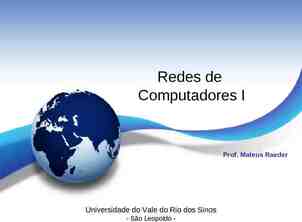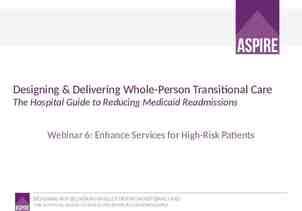ITS ePrimer Introduction and Overview ITS Professional Capacity
33 Slides1.47 MB
ITS ePrimer Introduction and Overview ITS Professional Capacity Building Program ITS Joint Program Office U.S. Department of Transportation
Instructor Pat Noyes Principal Pat Noyes & Associates Boulder, CO, USA U.S. Department of Transportation ITS Joint Program Office U.S. Department of Transportation 2
Learning Objectives Understand the history and current status of ITS Be familiar with the 16 subject modules Know how to access and use the ITS ePrimer U.S. Department of Transportation ITS Joint Program Office U.S. Department of Transportation 3
What is ITS? ITS applies information, technology, and systems engineering to the management and operation of surface transportation facilities It is an engineering discipline that encompasses Research Planning Design Integration Deployment U.S. Department of Transportation ITS Joint Program Office U.S. Department of Transportation 4
Introduction to ITS ITS brings diverse disciplines together to deliver Safe Efficient Sustainable transportation ITS enhances transportation infrastructure investments ITS supports system management and operation Multimodal Local, regional, state U.S. Department of Transportation ITS Joint Program Office U.S. Department of Transportation 5
Examples of How ITS Enhances Our Lives Adaptive signal control technology uses realtime traffic information to Cut costs Reduce congestion Improve traffic flow Reduce emissions Respond to incidents, special events, and recurring congestion Source: http://www.fhwa.dot.gov/everydaycounts/technology/adsc/intro.cfm. U.S. Department of Transportation ITS Joint Program Office U.S. Department of Transportation 6
Examples of How ITS Enhances Our Lives (cont’d) Crowdsourcing for Advanced Operations Provides real-time information on travel speed and time, traffic incidents, travel behavior, and vehicle operation Data can be used by TMCs to manage the system and provide traveler information Source: Crowdsourcing for Advancing Operations EDC-6 Factsheet /. U.S. Department of Transportation ITS Joint Program Office U.S. Department of Transportation 7
Where ITS Can Be Applied Multimodal Auto Transit Freight Bicycles Pedestrians Facility Types U.S. Department of Transportation ITS Joint Program Office Highways Arterials Fixed guideways Bikeways Sidewalks Multimodal facilities Ports and terminals U.S. Department of Transportation 8
Systems Engineering Source: USDOT U.S. Department of Transportation ITS Joint Program Office U.S. Department of Transportation 9
Transportation Challenges Increasing demand: 115 percent increase in VMT over 39 years Minimal increase in capacity: Less than 11 percent increase in number of lane miles in same period 140% Percent Change 1980-2019 120% 100% 80% 60% 40% 20% 0% Public Road Mileage Lane Miles U.S. Department of Transportation ITS Joint Program Office VMT Source: FHWA Highway Statistics, 2019. U.S. Department of Transportation 10
Transportation Challenges (cont’d) Funding levels have not kept pace with needs, increasing pressure to do more with less Highway Trust Fund Expenditures (in billions) 50 45 40 35 30 Actual 1980 25 20 15 10 5 0 1980 1990 2000 2010 2019 Source: FHWA Highway Statistics, 2010 and ENO Center for Transportation U.S. Department of Transportation ITS Joint Program Office U.S. Department of Transportation 11
Workforce Needs Traffic Data Scientist/Statistician TSMO Manager/Chief/Bureau Director TSMO Program Manager Computer Engineer Artificial Intelligence Scientist Telecommunications Engineer Data Management Specialist Visualization Specialist Connected and Automated Vehicles (CAV) Program Manager Traffic Incident Management (TIM) Program Manager Cyber Security Engineer Transportation Data Ethicist Surface Weather Specialist Systems Engineer TSMO Modeling Specialist Emerging Technologies Industry Liaison Transportation Systems Performance Manager Integrated Corridor Management Manager Transportation Management Center Manager U.S. Department of Transportation ITS Joint Program Office U.S. Department of Transportation 12
Benefits of ITS Improved safety Reduced congestion Reduced emissions Reduced travel times Enhanced access and quality of life Crash prevention Cost savings for commercial vehicle operations Enhanced travel options U.S. Department of Transportation ITS Joint Program Office U.S. Department of Transportation 13
History of ITS USDOT ITS JPO published a History of ITS on their website History of Intelligent Tran sportation Systems (dot.g ov) U.S. Department of Transportation ITS Joint Program Office U.S. Department of Transportation 14
History of ITS 1988: Mobility 2000 – working group focused on national program of automated technology 1991: ISTEA – encouraged new technologies to improve safety, information exchange, system capacity, and travel times 1990s: National Architecture and Standards Program initiated Late 1990s: Term "ITS" emerged to include more multimodal focus U.S. Department of Transportation ITS Joint Program Office U.S. Department of Transportation 15
History of ITS (continued) 2012: Moving Ahead for Progress in the 21st Century (MAP-21) – created a streamlined, performance-based surface transportation program with an increased focus on system management 2014: NHTSA proposed rulemaking supporting V2V communication technology research 2015: Fixing America’s Surface Transportation (FAST) – largely continued previous program structures with an 11 percent increase in funding over 5 years U.S. Department of Transportation ITS Joint Program Office U.S. Department of Transportation 16
USDOT CARMA Program U.S. Department of Transportation ITS Joint Program Office U.S. Department of Transportation 17
ITS JPO Strategic Plan 2020-2025 Vision To accelerate the use of ITS to transform the way society moves Mission To lead collaborative and innovative research, development, and implementation of IT to improve the safety and mobility of people and goods U.S. Department of Transportation ITS Joint Program Office U.S. Department of Transportation 18
ITS JPO Research Priorities U.S. Department of Transportation ITS Joint Program Office U.S. Department of Transportation 19
ITS Architecture and Standards National ITS Reference Architecture (ARC-IT) Guides ITS programs at the national level Regional Architecture Development for Intelligent Transportation (RAD-IT) Supports regional and project ITS architectures Systems Engineering Tool for IT (SET-IT) Tool to integrate drawing and database tools with ARC- IT U.S. Department of Transportation ITS Joint Program Office U.S. Department of Transportation 20
ARC-IT Reference architecture that provides common basis for planners and engineers Does not mandate any particular implementation Provides tools to develop regional architecture U.S. Department of Transportation ITS Joint Program Office U.S. Department of Transportation 21
ITS Standards and Architecture U.S. Department of Transportation ITS Joint Program Office U.S. Department of Transportation 22
Growth of ITS Deployment ITS deployment is growing rapidly, nationally, and globally The global value of the ITS market was estimated over 26 million in 2021 Projected growth at 7 percent over the next 7 years expected - 42 million by 2028 U.S. Department of Transportation ITS Joint Program Office U.S. Department of Transportation 23
Areas of Growth in ITS Freeway management Arterial management Incident management Transit management Future deployment plans Connected vehicles and automated vehicles U.S. Department of Transportation ITS Joint Program Office U.S. Department of Transportation 24
How to Use the ITS ePrimer Modules are structured around specific topic areas and intended to stand on their own 16 different authors – level of detail varies across modules, and some topics are crosscutting/overlapping U.S. Department of Transportation ITS Joint Program Office U.S. Department of Transportation 25
Content Outline 1. Introduction to ITS Provides an overview of ITS including history, benefits, and future vision 2. Systems Engineering Presents an overview of systems engineering and its relation to ITS architecture, planning, and deployment 3. Application of ITS to TSMO Provides an overview of ITS technology and tools used to manage transportation strategies, systems, and networks U.S. Department of Transportation ITS Joint Program Office U.S. Department of Transportation 26
Content Outline (cont’d) 4. ITS Data in Decision Making Introduces fundamentals related to collecting, storing, analyzing, and sharing ITS data to manage performance and improve decision-making 5. ITS to Support Travelers Focuses on ITS applications to support multimodal transportation: information, safety, convenience 6. Freight and Commercial Vehicle ITS Illustrates and explains major ITS applications related to freight management and commercial vehicle operations U.S. Department of Transportation ITS Joint Program Office U.S. Department of Transportation 27
Content Outline (cont’d) 7. Public Transportation Identifies a broad range of ITS applications in public transportation and describes how they enhance efficiency, convenience, safety, and security 8. Electronic Tolling and Pricing Provides an introduction to electronic payment systems applications and pricing strategies 9. Supporting ITS Technologies Describes various supporting ITS technologies and considers opportunities for deployment and integration U.S. Department of Transportation ITS Joint Program Office U.S. Department of Transportation 28
Content Outline (cont’d) 10. Rural and Regional ITS Applications Identifies unique transportation needs in rural areas and applies lessons from successful ITS deployments in rural and regional settings 11. Sustainable Transportation Explores opportunities to integrate ITS technologies in support of sustainable transportation 12. Institutional Issues Defines institutional challenges encountered in planning, deploying, and maintaining ITS and provides guidance on addressing institutional concerns U.S. Department of Transportation ITS Joint Program Office U.S. Department of Transportation 29
Content Outline (cont’d) 13. Connected Vehicles Examines current and emerging CV technologies and discusses institutional, policy, legal, and funding challenges associated with CV applications 14. ITS in Emergencies and Disasters Provides information on how ITS can support transportation operations during emergencies and disasters U.S. Department of Transportation ITS Joint Program Office U.S. Department of Transportation 30
Content Outline (cont’d) 15.Port Operations Provides an overview of ITS related to port operations and supports expanded port participation in ITS applications 16.ITS Emerging Opportunities and Challenges Explores 4IR technologies and how developments in data, computing, and telecommunications are impacting ITS and transportation profession U.S. Department of Transportation ITS Joint Program Office U.S. Department of Transportation 31
ITS ePrimer Online Products Available online 16 modules PowerPoint slides with speaker notes and suggested audience interaction for each module U.S. Department of Transportation ITS Joint Program Office U.S. Department of Transportation 32
Resources ITS ePrimer: www.pcb.its.dot.gov/eprimer ITS Professional Capacity Building (PCB): www.pcb.its.dot.gov National Highway Institute (NHI): https://www.nhi.fhwa.dot.gov ITE Webinars: www.ite.org ITS JPO PCB Program: [email protected] U.S. Department of Transportation ITS Joint Program Office U.S. Department of Transportation 33






































